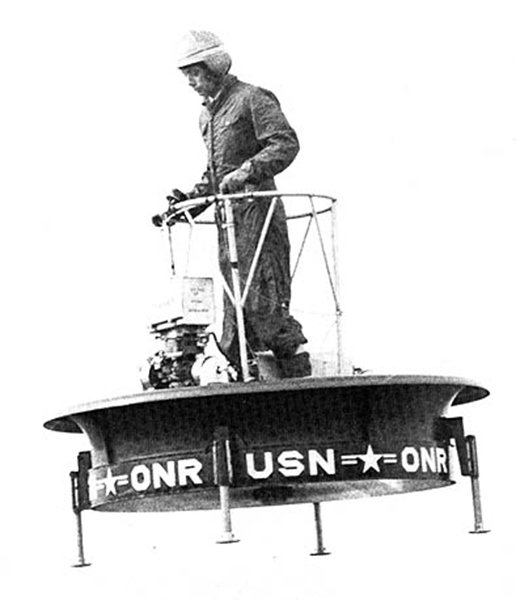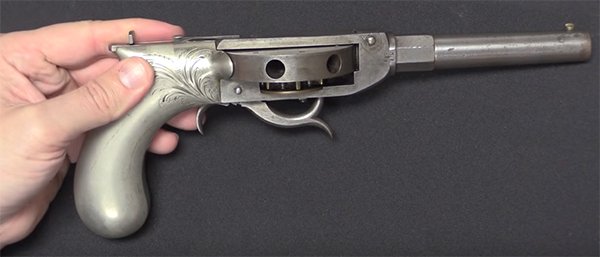Hilariously Stupid Weapons Someone Thought Would Actually Work In Battle
by Pauli Poisuo
Weapons, weapons, weapons! We here at the Modern Rogue have a fair few videos of how to make or use them, so it’s easy to think that actual professionals in charge of designing them for the battlefield would have a pretty good handle on how the process works.
Still, every once in awhile, weapon designers come up with something so profoundly, obviously insane, you'd think their ancestry was half cartoon.
Tancik vz. 33: The Tank That Could Not Tank
Tanks are fearsome weapons. They’re armored, massive, well-armed all-terrain vehicles that can destroy pretty much everything in their way. And then there is the Czechoslovakian Tancik vz. 33, whose designers took one look at traditional specs and achieved the exact opposite.
We’re going to sing you a metaphorical song about all the faults of the Tancik, but really, its most glaring fault can be pointed out by just looking at it:
G.I. Joe sold separately.
That’s just ... wow. Is it a troop carrier from the Clown Wars? Does an infinite line of red-nosed commandos flood out once it stops in the middle of the ring? Is it a tiny float for a small-town parade? It can't be an actual vehicle of war someone built for battle, right?
Unfortunately for its users, it’s that last one. In 1930, someone proposed to the Czechoslovakian military that it might be a neat idea to buy a few British post-WWI Carden-Lloyd tankettes, and use them as a template to built their own, hilariously tiny battalion of tanks. We hoped to discover that they had some tactical advantage in mind, like maybe a forced perspective trick that would enable the Czech military to drive right up to the enemy while they think that they’re being approached by regular-sized tanks that are really far away. However, it appears that the reason behind green-lighting the Tancik was good, old fashioned money: Small tanks are cheaper than huge ones.
As the Czech higher-ups were about to find out, they’re also much, much worse at tanking. The 70 manufactured Tanciks were not only bad -- they were hilariously bad. They were severely underarmored, and their weapons consisted of two machine guns that, frankly, would have been more useful if the two guys manning the machine just pried them off the vehicle and charged at the enemy on foot.
"WHEEEEEEEEEEE!"
As you can probably imagine, the Tancik didn’t have much in the way of suspension. Its steering was ridiculously complex, and the ride was pretty damn rough. The cramped insides of the vehicle meant that the poor guy tasked with driving also had to operate the machine guns, which were hard to reach and next to useless, thanks to the the jerky movements of the Tancik.
If the near-complete lack of offensive and defensive capabilities and nigh-impossible steering weren’t enough, the Tancik had one last absurdly dangerous indignity to offer its crew: Because the tank didn’t feature a radio, they had to communicate with the outside world by physically sticking an arm out of the thing to give hand signals.
When your armored assault vehicle requires its crew to stick their hands outside the armor at regular intervals and gesture at the world, you’re either harboring an irrational hatred of hands or just a very bad weapons designer.
The Hiller Flying Platform: A Sci-Fi Fever Dream With Design Flaws To Spare
No one ever said the Hiller Flying Platform wasn’t an ambitious design. In a way, it was a product of its era: The Cold War in the 1950s was an optimal time in history to walk up to your superiors and say, “Yo, give me big bags of money to design a rotor platform that I saw in a peyote vision.”
The look of shame on his face tells the whole story.
The Hiller platform took its first tentative flight in 1955. Its concept was a cross between a Segway and the Green Goblin’s flying glider from the Spider-Man comics: A round platform with a direct-lift rotor, steered by the pilot leaning his body in the desired direction. This was neat, as was the fact that it was designed in a way that made it impossible to tumble -- if you leaned too far, the platform would just pitch up and slow down.
However, there was an immediate problem when it came to the vehicle’s uses on the battlefield: It sucked. Siccing soldiers to war, balancing on precarious air Segways, is far from the greatest way to intimidate your enemy. The platform was difficult to control and far too mechanically delicate, heavy, slow and ungainly for military use. It probably didn’t help that the more they tweaked the platform’s design to improve its performance, the bigger it became.
The 4th would've been just a helicopter with a guy strapped on top.
Still, the Hiller platform wasn’t a complete failure. Stupid as it may have been, its technology provided important information about the performance of the ducted fan technology. By the 1960s, said technology started seeing use in another, much more successful method of transport: The hovercraft.
The Cochran Revolver: No One Is Safe, Including The Guy Holding The Gun
The Cochran revolver is a neat 19th century handgun with a cool design that kind of looks like a smiley face from the side. We’ll show you an image in a moment, but first, we want to see if you can figure out the one teensy, tiny problem in this particular design, based on the following hint:
Black powder revolvers have a fairly well-known problem called chainfire, which can happen when loose gunpowder forms a “powder train” between the chambers of the revolver and all the chambers will fire at once. Although this is preventable with proper firearm maintenance, you can probably guess that shooting once and having every bullet fire itself at the same time is ... not the greatest scenario, especially when you have to fix up the pistol afterwards.
Now, let’s take a look at the Cochran revolver. Can you figure out why it never caught on?
"Bullets for everyone! Catch!"
If you guessed that a chainfire incident would send bullets flying in every direction, up to and including the shooter’s own face, step up and claim your prize of never having to fire a poorly maintained Cochran revolver. See, its full name is Cochran turret revolver, meaning that its axis of rotation is perpendicular to the chamber, as opposed to the more well-known, parallel-rotation models.
Despite the fairly glaring design flaw of potentially turning every pull of the trigger into a game of 360° Russian Roulette, the Cochran was one of the most common turret-style revolvers in the US. Though, considering that only around 150 were ever made, it didn’t exactly crack the consumer market.
Sizaire-Berwick Wind Wagon: The Little Desert Vehicle That Couldn’t
History dances around the Sizaire-Berwick Wind Wagon like a giant pair of scissors had expertly cut it from the fabric of time itself. What few mentions of the vehicle can be found online do verify that it once existed, but the actual details tend to be quick, one-paragraph run-throughs: “Yeah, and at one point they built this stupid thing. Ok, cool. The End.”
It’s as if reality itself recognized the abject stupidity of this 1915 armored, propeller-powered battle car and attempted to erase it. This is actually pretty understandable when you see it in the flesh and realize that it’s that same damn flying car you drew with crayons when you were five:
We're surprised there isn't a smiley-face sun in the sky.
To be fair, the Wind Wagon didn’t actually fly. It was designed as a specialized desert vehicle, because WWI-era cars weren’t doing too well on sandy terrain. Unfortunately, neither was the Sizaire-Berwick company, based on how they tackled the challenge. The 110-horsepower aircraft engine stuck at the back of the Wind Wagon was supposed to take care of the “getting stuck in the sand” issue, while the steel armor of the cabin and the Vickers machine gun took care of the vehicle’s combat readiness. Unfortunately, there were a few strategic errors with the design: They had neglected to armor the car’s radiator and the engine, meaning that the Wind Wagon could easily be crippled by enemy fire from any and all directions. Also, deserts tend to be made of sand, and revving a propeller aircraft engine roughly three feet above it, presumably wouldn’t have done any favors for its long-term functionality.
Shockingly enough, the British army wasn’t overly enthusiastic about deploying a fleet of easily immobilized desert saunas at its enemies. The Wind Wagon project was quietly taken behind the shed after just one prototype had been built.
The GyroJet: Tragically, Rocket Guns Are Useless
In terms of plain awesomeness, the concept behind the GyroJet is to firearms what lightsabers are to swords. In fact, this 1960s gun is not only awesome enough to have been featured as a gadget in the James Bond movie You Only live Twice -- it’s so awesome that they actually had to present it as a Japanese invention. The GyroJet is a cool, if a little unassuming-looking, pistol that just happens to fire mini-rockets instead of bullets. Yes, this is a rocket gun. Yes, of course the rockets it fires are powered with actual rocket fuel. There’s even a badass exhaust effect from the sides of the gun when you fire it!
The poster for A Christmas Story was awesome.
The GyroJet was light. The GyroJet was powerful. The GyroJet was so, so awesome. On paper.
There’s a reason that 100% of warfare doesn’t consist of people blasting hand-held gun-rockets at each other, and if you’ve ever launched a bottle rocket, you can probably guess why. The rockets the GyroJet fires start up slowly, picking up speed as they go. This means that the gun is pretty much nonlethal at distances under 10 feet, which just so happens to be the ideal range for pistol encounters. Beyond that, it’s incredibly powerful, but roughly as accurate as a signal flare. That is to say, not in the slightest.
The military saw little use for a weapon that either tickled you or threw drunken, wildly inaccurate haymakers at your approximate vicinity. Still, there’s no keeping a good, bad idea down. Determined to make a profit from their creation, the manufacturers tinkered on, eventually creating around 60 versions of their absurd rocket-gun. Perhaps fittingly, their design aesthetic tended to be less “badass weapon of mayhem” and more “your 6-year-old cousin’s water shooter:”
These are so childlike, they should be characters in the next Toy Story.
The rifle variation didn’t fare any better, looking for all the world like an unconvincing dummy gun that a prisoner might MacGyver together out of timber and soap:
We've made more realistic looking guns out of macaroni.
And then there’s the underwater spear gun version, which looks like an action figure accessory that’s rejected for looking too much like a child's toy, somehow:
Somewhere, Aquaman is laughing his ass off.















